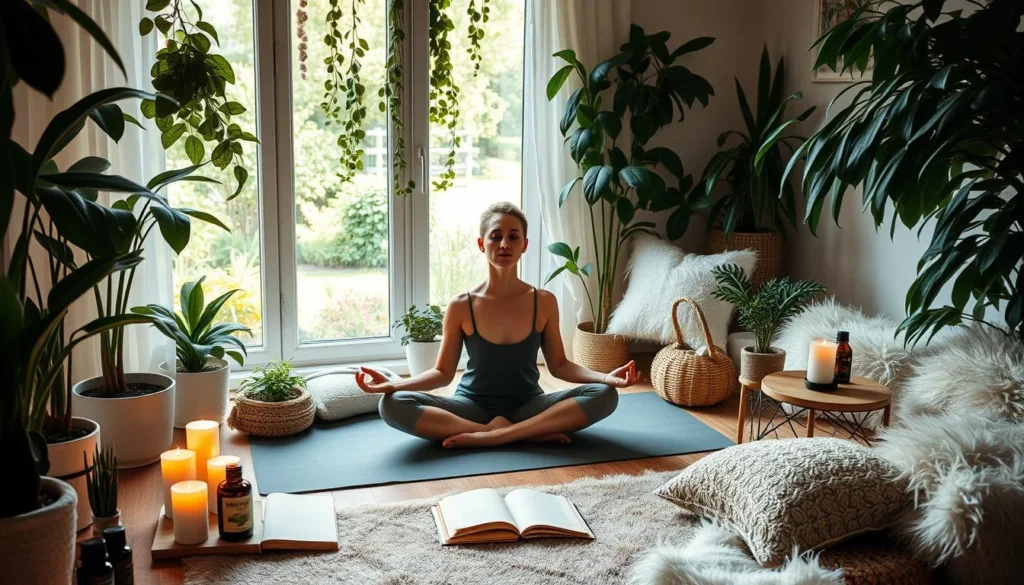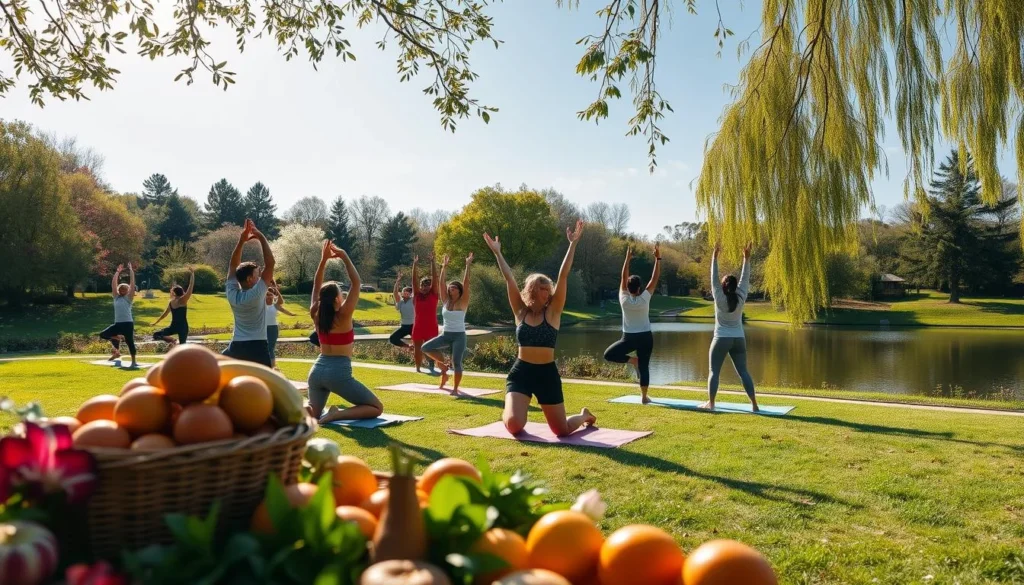Did you know only 23% of adults are active regularly? Yet, those who are active feel much better mentally and emotionally. This shows how a vibrant lifestyle can boost our happiness and wellness. We’ll look at ways to improve your mental, emotional, and physical health. By doing so, you can make your life more joyful and fulfilling.
We’ll cover mindfulness, healthy habits, and building strong relationships. We’ll also talk about making your environment better. These steps are key to a happy life. Start your journey to a vibrant lifestyle today!
Key Takeaways
- Regular physical activity greatly improves mental health.
- Activities like hiking and gardening connect us with nature.
- Green spaces in cities improve our quality of life.
- Eating well supports our emotional and intellectual health.
- Mindfulness helps us grow and find peace.
- Self-care is crucial for our overall well-being.
Understanding the Concept of a Vibrant Lifestyle
A vibrant lifestyle is more than just being physically healthy. It also includes emotional and mental well-being. To achieve a life balance, you need to know your values and put them first in your daily choices. Building meaningful connections is key to growing personally and feeling fulfilled.
Creating well-being habits is crucial for your health. Activities like walking or swimming can boost your mood by releasing happy hormones. These habits, along with healthy eating and sleep, are essential. Keeping in touch with family is also important for emotional support during tough times.
Thinking deeply about your lifestyle helps you understand what makes it vibrant. Spiritual practices like meditation or prayer can clear your mind and lower stress. These activities bring peace and balance to your emotional and social life.
In the end, a vibrant lifestyle is about more than just doing things. It’s about building real relationships, growing as a person, and finding your own definition of well-being.
Strategies for Wellness and Happiness

To find wellness and happiness, we need to understand how different parts of life connect. Learning about emotional balance helps us care for our mind, body, and spirit. A balanced life includes good food, exercise, and emotional health.
Exploring Holistic Approaches
Holistic wellness treats the whole person, not just parts. It sees how physical health, mental clarity, and emotions are linked. To improve wellness and happiness, we can:
- Mindfulness practices to enjoy the now.
- Engage in the community for support and well-being.
- Eat mood-boosting foods like omega-3s and whole grains.
Balancing Mind, Body, and Spirit
Keeping mind, body, and spirit in balance is key to well-being. This balance helps us stay strong and emotionally stable. It includes:
- Regular exercise for better mental health.
- Strong relationships for emotional support.
- Acts of kindness and gratitude for positive feelings.
Dr. Martin Seligman’s PERMA Model shows how to live a fulfilling life. It focuses on positive emotions, engagement, relationships, meaning, and accomplishment. By using these strategies, we can improve our emotional balance and find more joy and wellness.
| Strategy | Description | Benefits |
|---|---|---|
| Mindfulness | Focusing on the present moment to increase awareness. | Improves mental clarity and emotional stability. |
| Physical Activity | Engaging in regular exercise. | Boosts self-esteem and reduces anxiety. |
| Social Connections | Building and nurturing relationships. | Provides emotional support and enhances life satisfaction. |
| Acts of Kindness | Engaging in altruistic behaviors. | Creates positive feelings and strengthens connections. |
| Nutrition | Prioritizing a balanced diet. | Impacts mood and overall physical health. |
Cultivating Healthy Habits for Holistic Wellness
Creating healthy habits is key to overall wellness. Focus on eating well, staying active, and getting enough sleep. These steps help improve your mental and emotional health.
Incorporating Nutrition into Daily Life
Eating a balanced diet with whole foods is essential for health. Fruits and vegetables are must-haves. Sadly, only 1 in 10 adults eats enough of these.
Having a diet full of nutrients is good for both body and mind. It helps keep emotions stable and thoughts clear. Tips for better nutrition include planning meals, keeping healthy snacks ready, and drinking 8 glasses of water a day.
Engaging in Regular Physical Activity
Regular exercise is important for both body and mind. Yet, only 23% of adults get enough exercise. Activities like walking, swimming, or group classes can help.
Exercise also boosts mood and helps with anxiety and depression. Making fitness a part of your daily life makes it fun.
Establishing Consistent Sleep Routines
Good sleep habits are crucial for wellness. Sadly, 50-70 million adults in the U.S. have sleep issues. Going to bed and waking up at the same time each day improves sleep.
Wellness tips include a calming bedtime routine, less screen time before bed, and a cozy sleep space. The National Sleep Foundation offers great advice on better sleep.
The Importance of Mindfulness Techniques

Adding mindfulness techniques to your daily life can make a big difference. It helps you feel more emotionally stable and less stressed. Mindful meditation is a key practice that brings clarity and calm to our busy lives.
By using these techniques, you can connect more deeply with yourself. This connection is key to better mental health.
Practicing Mindful Meditation
Mindful meditation is a core part of living a centered life. Studies show it can lessen anxiety and depression symptoms. It helps you relax and improves your life quality, even with chronic health issues.
Jon Kabat-Zinn recommends meditating for at least 45 minutes. He says it’s crucial for treating issues like substance abuse and anxiety.
Incorporating Mindfulness into Daily Tasks
Mindfulness can make everyday moments special. Even simple tasks like eating or walking can become opportunities for insight. It helps you notice your behaviors and habits better.
This mindfulness boosts body awareness. It can also help with eating habits, reducing binge or emotional eating. So, making your daily routines mindful can greatly improve your mental health.
Building and Nurturing Meaningful Connections

Meaningful connections are key to a happy life. Supportive relationships boost our emotional health, bringing joy and strength. Talking and sharing with others makes us happier and helps us face life’s ups and downs.
Research shows people with strong social ties live up to 50% longer. This highlights how important our relationships are.
The Role of Supportive Relationships in Well-Being
Good relationships keep our emotions healthy. Studies reveal that close bonds can cut mortality risk by 45%. This means having caring people around us can protect us from stress and tough times.
Feeling lonely is common, with 20% to 43% of Americans over 60 often feeling alone. But, having supportive friends can help fight loneliness.
Effective Communication Strategies for Stronger Bonds
Good communication is key to strong relationships. Listening well, saying thank you, and doing things together can make bonds stronger. For example, exercising with friends can make us feel more connected by 60%.
Using these tactics can make us feel more understood and empathetic, boosting our well-being by 30%. Building strong relationships not only improves our emotional health but also makes life more fulfilling and connected.
| Statistic | Insight |
|---|---|
| 50% | Increased likelihood of longevity with strong social connections. |
| 45% | Reduction in mortality risk through meaningful relationships. |
| 60% | Increased feelings of connection when participating in group activities. |
| 30% | Increase in overall well-being and life satisfaction from empathetic relationships. |
| 20% | Decrease in likelihood of depression with a supportive social network. |
Self-Care Practices to Boost Happiness

Self-care is key to feeling happy and well. It helps keep your mind and body healthy. This part talks about good self-care habits that fit your life.
Exploring Various Self-Care Routines
There are many self-care ways, and finding yours is important. Some great self-care habits include:
- Mindfulness Practices: Studies show mindfulness can make you happier at work and reduce burnout.
- Physical Activity: Exercise releases happy hormones that improve your mood and lower stress.
- Creative Outlets: Doing things like drawing or crafting can calm you down and reduce anxiety.
- Social Engagement: Going to social events or hanging out with friends can fight loneliness.
- Gratitude Journaling: Writing about things you’re thankful for can make you feel better and less stressed.
Creating a Personal Self-Care Plan
To make a good self-care plan, pick activities that fit your life. Here’s how to start:
- Identify Your Needs: Think about what you need to take care of your mind and body.
- Select Activities: Pick things that match your needs, like exercise, creative stuff, or mindfulness.
- Schedule Regular Time: Plan to do self-care regularly to keep yourself well.
- Evaluate and Adjust: Check your self-care plan often and change it as needed to stay on track.
Embracing a Positive Mindset

A positive mindset is key to lasting wellness and happiness. By using certain techniques, you can see life in a more optimistic way. This section will show you how to be more positive and why gratitude is important for your emotional health.
Techniques to Shift Perspective
Changing how you see things can make you happier. Methods like cognitive restructuring and positive affirmations help. Using positive affirmations can replace negative thoughts, making you more resilient and confident.
Studies show that positive people tend to make better choices. They eat well and exercise regularly. These actions improve both physical and emotional health.
Practicing Gratitude Daily
Adding gratitude to your daily life can greatly improve your mood. Keeping a gratitude journal is a simple way to focus on the good things. Many studies show that gratitude boosts mood and builds resilience.
Gratitude makes you appreciate life more, leading to a richer emotional experience. Positivity also releases happy chemicals in the brain. These chemicals, like dopamine and serotonin, make you feel happier and more well-rounded.
Stress Management Tools for a Balanced Life
Effective stress management tools are key to a balanced life. Knowing what causes stress is the first step. Once you know, using relaxation techniques can make life more peaceful.
Identifying Stress Triggers
Knowing what causes stress helps you take control. Common stressors include:
- Work-related pressures
- Relationship conflicts
- Financial worries
- Health concerns
By identifying these triggers, you can create strategies to manage stress. Getting help from counselors or journaling can help find deep causes of stress.
Exploring Relaxation Techniques
Adding relaxation techniques to your daily routine can reduce stress. Here are some effective methods:
- Meditation: A powerful way to promote calm and enhance well-being.
- Yoga: Combines physical movement and controlled breathing, serving as a great stress reliever.
- Coloring: Engaging in this creative outlet can reduce anxiety and provide a meditative effect.
- Listening to Music: Lowers stress hormones and offers a mental distraction.
- Aromatherapy: Certain scents can promote relaxation and decrease stress levels.
Using these techniques can make life easier. A healthy lifestyle, including sleep, exercise, and mood-boosting foods, helps handle stress. Also, make time for fun activities to relax and enjoy.
| Relaxation Technique | Benefits |
|---|---|
| Meditation | Promotes calm and emotional balance |
| Yoga | Reduces muscle tension and increases flexibility |
| Coloring | Encourages creativity and lowers anxiety levels |
| Listening to Music | Provides mental distraction and alleviates stress hormones |
| Aromatherapy | Enhances mood and reduces stress response |
By using these strategies, you can build a stress management toolbox. This helps keep your life balanced and well.
Ways to Cultivate Joy in Daily Life
Adding joy to our daily lives can make us happier. Fun activities give us breaks and help us relax. Hobbies and interests also bring us fulfillment and emotional well-being.
Incorporating Fun Activities
Adding fun to our schedules makes life more vibrant. Here are some ideas:
- Outdoor adventures: Try hiking, biking, or picnics for fresh air.
- Creative expression: Art, music, or crafting can boost creativity and reduce stress.
- Social gatherings: Game nights or casual meetups with friends can bring laughter and connection.
These activities help us find joy in our daily lives. They improve our mood and strengthen our bonds with others.
The Benefits of Hobbies and Interests
Hobbies offer many benefits that make life richer. Here are a few:
| Benefit | Description |
|---|---|
| Enhances Skills | Hobbies help us learn new things and grow personally. |
| Reduces Stress | Enjoyable activities can lower stress and improve mental health. |
| Fosters Connections | Sharing interests can strengthen relationships and build social networks. |
| Boosts Happiness | Following our passions can make us happier overall. |
In summary, hobbies and fun activities are key to well-being. Cultivating these interests can make our lives happier and more fulfilling.
Creating a Vibrant Environment
Creating a vibrant environment greatly improves well-being in both personal and work spaces. Being close to nature boosts mental health. Thoughtful design also adds to the positive feeling of a place. This section looks at how adding natural elements can change how we feel and work.
The Impact of Nature on Well-Being
Studies show nature’s big impact on health. People in lively environments are 33% more engaged and productive than others. Natural light makes us happier and can increase productivity by 12%.
Adding plants and natural materials to workspaces connects us to nature. This lowers stress and encourages healthy habits. It even helps reduce obesity by making physical activity easier.
Designing Your Space for Positivity
Designing spaces for positivity means making them both beautiful and useful. Here are key things to think about:
- Decluttering: A tidy space reduces anxiety and helps us think more clearly.
- Incorporating Plants: Plants can make us feel better and improve the air we breathe.
- Using Uplifting Colors: Bright colors spark creativity and positivity.
- Creating Open Layouts: Open spaces help people work together better.
- Access to Natural Light: Lots of daylight makes a space feel better and is good for our health.
Companies that focus on these design elements see big benefits. They keep employees longer and make them happier. The choices we make in design today affect how productive, creative, and happy we are.
Conclusion
As we wrap up our look at what makes life vibrant, it’s clear that wellness is a personal and rewarding journey. By using the happiness strategies we’ve talked about, you can boost your mental health. This can lead to better relationships and a higher quality of life.
Happiness is not just a feeling; it’s a skill you can learn. This skill helps you face challenges with strength and resilience.
It’s crucial to take care of your physical health through exercise, healthy eating, and enough sleep. These habits not only keep your body healthy but also improve your mental state. Don’t forget the importance of staying hydrated and practicing mindfulness.
These habits help lower stress, strengthen your immune system, and even improve heart health. All these are key to living a happier and longer life.
By adopting these strategies, you’ll not only improve your own life but also the lives of those around you. This creates a supportive space for joy and growth. Start investing in yourself today. Watch as your vibrant lifestyle grows, filling your journey with happiness and fulfillment.
Source Links
- Wellness Insights – Your Gateway to a Healthier Life
- Embrace a Vibrant Lifestyle: Your Guide to Living Well
- Wellness Month: A Guide to Health and Happiness for Seniors
- How to Live a Healthy Lifestyle: Essential Steps for Wellness
- Cultivating the 9 Dimensions of Wellness at Work
- Positive Psychology Strategies for Increased Happiness
- 5 steps to mental wellbeing
- How to Be Happy: 27 Habits to Help You Live a Happier Life
- 10 Daily Habits for Holistic Well-Being
- Achieving Optimal Health: A Holistic Approach to Wellness
- Cultivating Healthy Lifestyle Habits: A Comprehensive Guide
- Mindfulness for Your Health
- Benefits of Mindfulness – HelpGuide.org
- Nurturing Connections: The Heartbeat of Wellness – HEAL United
- 5 Ways Social Wellness Will Improve Your Attitude and Happiness
- Nurturing Social Connection: The Key To A Healthy Mind
- Self-Care Strategies to Improve Your Overall Mental Health
- These Easy Self-Care Activities Can Dramatically Improve Your Life
- The Power of Positive Thinking
- Embrace Positive Thinking for a Happier Life
- 12 tips to tame stress
- 18 Highly Effective Stress Relievers
- Cultivate Joy to Improve Well-being | IE Insights
- Cultivating Happiness – HelpGuide.org
- 10 Strategies for Fostering a Vibrant Workplace – BetterYou
- Creating Healthy and Vibrant Urban Spaces: Design Strategies for Wellness – Charleston Civic Hub
- How to Be Happy: 10 Tips and Strategies for a Fulfilling Life
- Happiness for Beginners (Part 8/8): Physical Well-Being and Conclusion— Happiness On Demand

